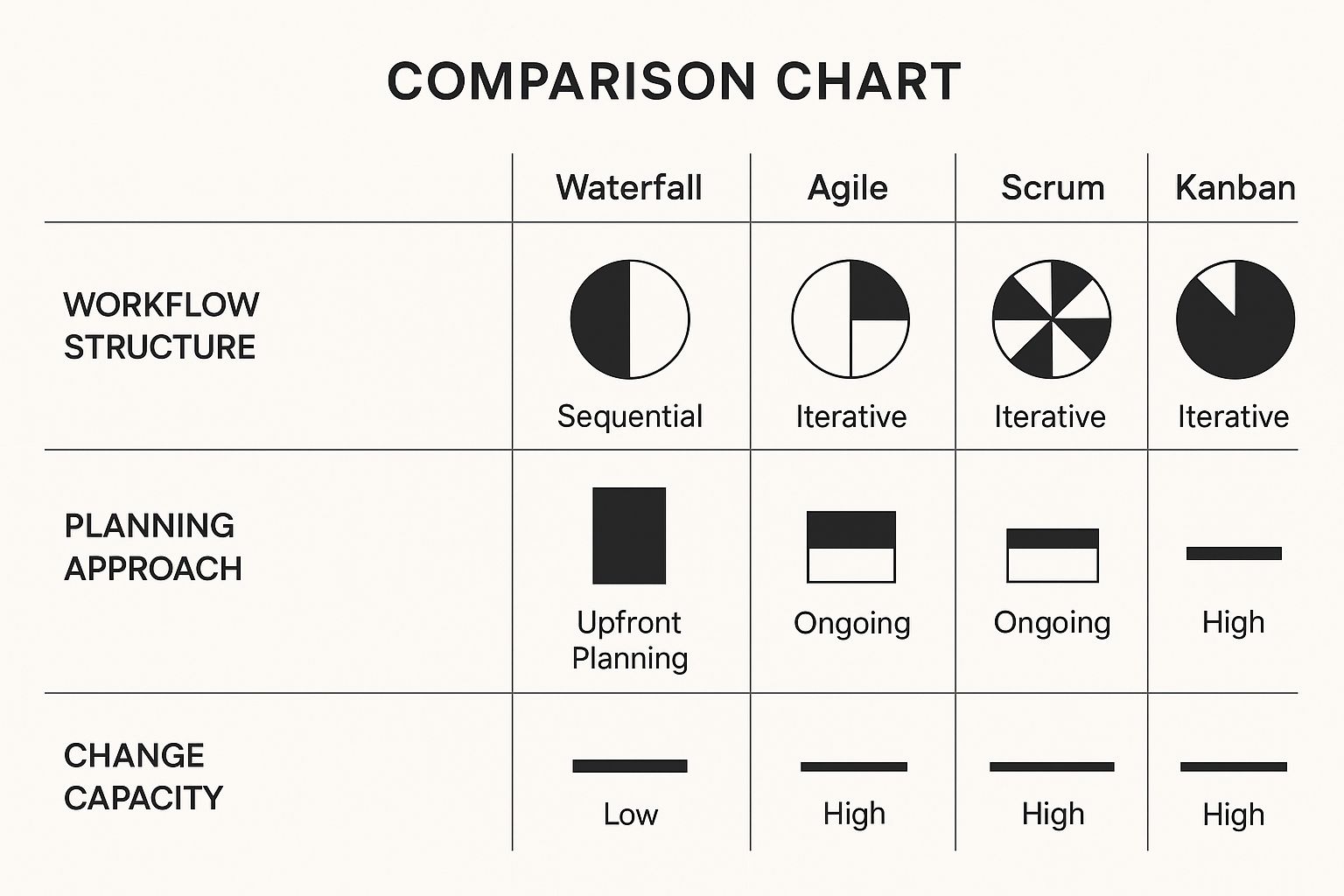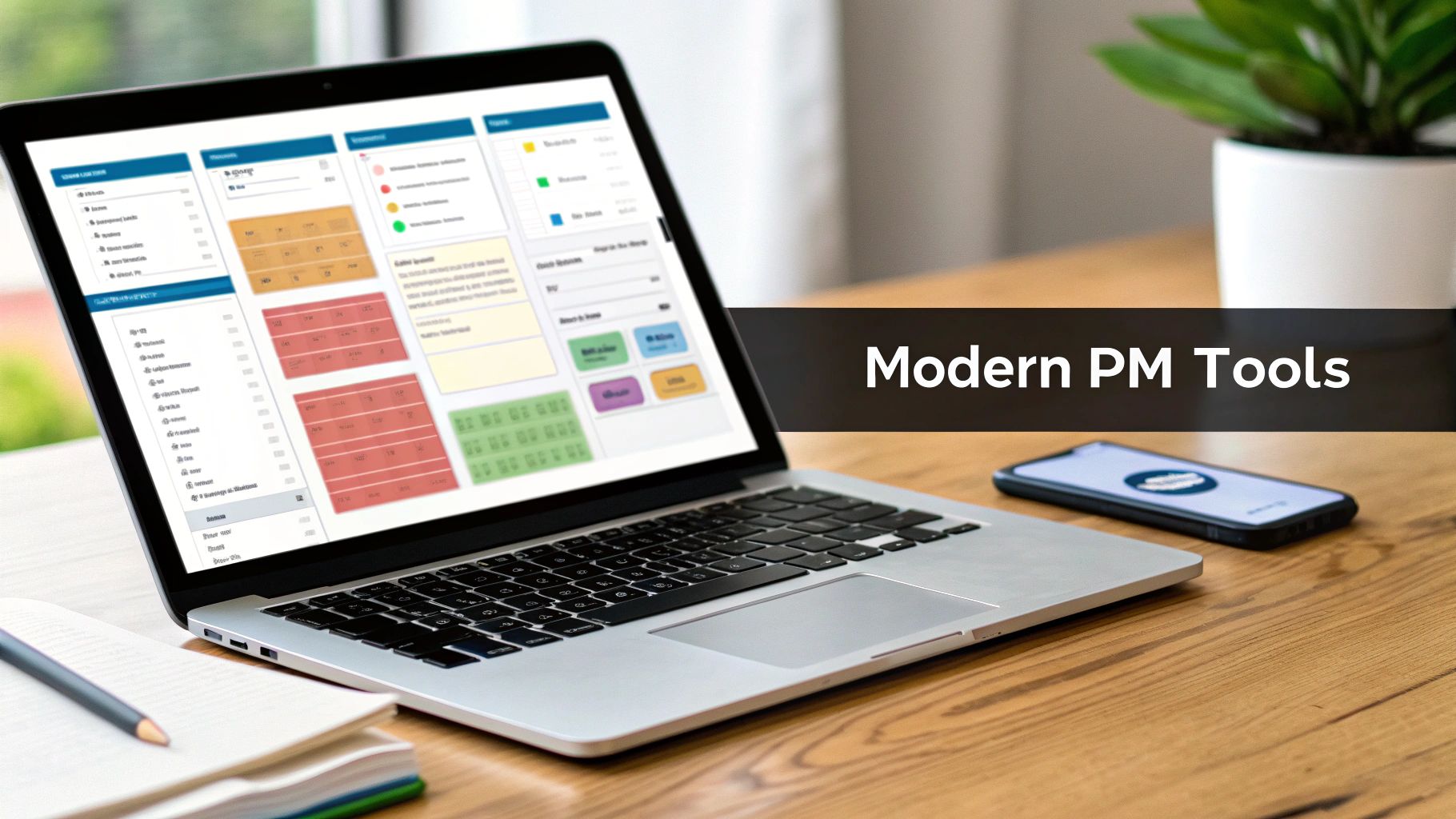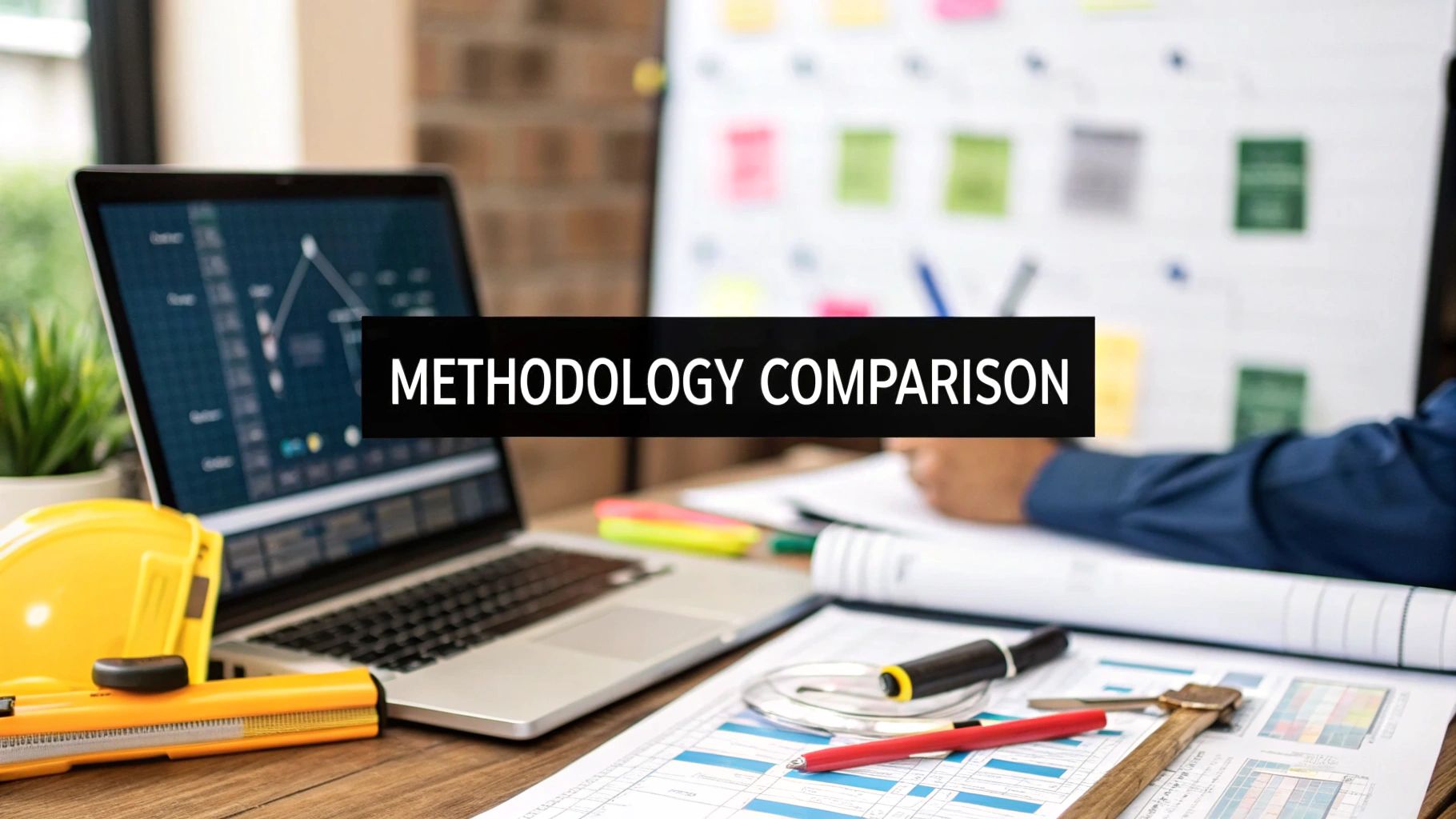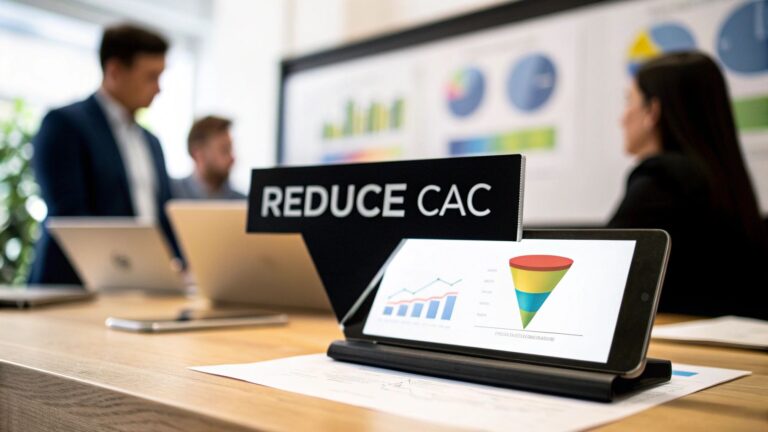Project Management Methodology Comparison
Choosing a project management methodology boils down to a fundamental trade-off. Do you need the rigid, step-by-step predictability of Waterfall, or the responsive, adaptive nature of Agile? The best path forward really depends on one thing: whether your project has a fixed, known outcome or if it needs room to breathe and evolve.
Why Your Methodology Choice Matters

Picking the right methodology isn't just a box to check—it’s one of the most impactful decisions you'll make for your project. This isn't about chasing the latest trend. It's about matching your team's workflow to the project's unique demands, budget, and ultimate goals. Get it wrong, and you’re looking at blown deadlines, budget creep, and a frustrated team. But when you get it right, the methodology becomes a powerful engine for success.
This guide will go beyond the textbook definitions. We’ll dig into a practical, real-world comparison of the major frameworks to help you make a smart, strategic choice that actually gets results.
Core Differences at a Glance
Before we get into the weeds, it helps to understand the big picture. Every framework is built on a different philosophy that shapes everything—from how you plan and execute work to how your team communicates with stakeholders. Think of this as a high-level map before we explore the territory in detail.
The global trend is clear: adaptable frameworks are winning. As of 2025, about 71% of organizations worldwide have adopted Agile methodologies, especially in fast-moving industries like tech. This isn't just a fad; the job market reflects it, too. North America now has over 930,000 PMP-certified professionals skilled in Agile, and Europe is seeing a 20% annual increase in project management roles. You can find more insights about project management trends and how they're reshaping industries.
The best project managers I know aren't married to one methodology. They have a whole toolkit of frameworks and know exactly when to pull out the right one for the job. They see every project as a unique problem that needs a custom-fit solution.
Being able to adapt is crucial for handling the complexities of modern projects. To make your initial comparison easier, the table below breaks down the fundamental differences between four of the most common approaches.
Foundational Methodology Comparison
This table gives you a quick snapshot of what makes each framework tick. Use it to get a feel for the core philosophy behind each one before we dive deeper.
| Methodology | Primary Goal | Workflow Structure | Change Management |
|---|---|---|---|
| Waterfall | Predictability and Control | Linear and Sequential | Discouraged; changes are costly and complex. |
| Agile | Flexibility and Customer Value | Iterative and Incremental | Welcomed and expected throughout the process. |
| Scrum | Rapid Product Delivery | Time-boxed Sprints (1-4 weeks) | Managed within sprint planning and backlogs. |
| Kanban | Continuous Flow and Efficiency | Continuous, Pull-based System | Handled in real-time as priorities shift. |
Predictive vs. Adaptive Methodologies

When you dig into project management, you quickly realize that most frameworks fall into one of two fundamental camps: predictive or adaptive. This isn't just about picking a process; it's a core philosophical choice that shapes how your team plans, executes, and deals with the unexpected. Getting this choice right is the first real step to finding a methodology that actually works for your project.
Predictive methodologies, like the classic Waterfall model, are exactly what they sound like. They operate like an architect's blueprint for a skyscraper. Every single detail—from requirements and design to testing and deployment—is planned out with painstaking detail before a single line of code is written or a single brick is laid.
The entire project scope is locked in from day one. This approach thrives on the assumption that you know exactly what you need to build and that those needs won't change. In this world, change is the enemy, a disruption that triggers formal, often cumbersome, change requests. The whole point is to achieve predictable results through tight control.
The Predictive Approach in Action
Think about a major civil engineering project. The specs for a bridge are non-negotiable; you can't just decide to use a different material or add another lane halfway through construction without derailing the entire endeavor. Success is measured by how well you stick to the original, highly detailed plan.
Key traits of a predictive model include:
- Heavy Upfront Planning: The lion's share of planning happens right at the start.
- Sequential Phases: One phase must be 100% complete before the next one can begin. Think of it like a series of dominoes.
- Rigid Documentation: Everything is documented in exhaustive detail, and this documentation is the law.
- Limited Stakeholder Contact: Once the initial requirements are signed off, stakeholders usually only reappear for major milestone reviews.
Embracing Change with Adaptive Methodologies
On the other end of the spectrum, you have adaptive methodologies, with Agile as the leading philosophy. If Waterfall is a rigid blueprint, Agile is more like a compass and a map. It gives you a clear direction but empowers the team to find the best path, responding to obstacles and opportunities as they arise.
Adaptive methods were developed specifically for industries where change isn't just possible, it's inevitable. Instead of trying to define the entire project at the outset, work is broken down into small, iterative cycles. Each cycle produces a small, functional piece of the final product, which allows the team to get constant feedback and adjust course. To see a direct comparison, check out our in-depth guide on Waterfall vs Agile project management.
The critical mindset shift from predictive to adaptive is moving from "scope rigidity" to "embracing change." Adaptive teams don't just tolerate change; they expect it and use it as a tool to deliver a better final product.
This is a natural fit for software development. Imagine building a new mobile app; market trends and user expectations can pivot in a flash. An adaptive approach lets the team build the most critical features first, release them, see how real users react, and then use that feedback to decide what to build next.
Key Differentiators Between Predictive and Adaptive
So, how do these two philosophies stack up in the real world? It goes much deeper than a simple pros and cons list. Let's break it down by a few key project dimensions.
1. How They Handle Project Scope
- Predictive: The scope is fixed, detailed, and non-negotiable from the start. Success means delivering that exact scope on time and on budget.
- Adaptive: The scope is fluid and expected to change. Success means delivering the most value to the customer, even if the final product looks different from the initial concept.
2. Their Approach to Planning
- Predictive: Involves massive upfront planning to map out every task, timeline, and resource for the entire project.
- Adaptive: Planning is an ongoing activity. A high-level vision is set early on, but detailed planning only happens at the beginning of each short work cycle (or sprint).
3. The Role of the Customer
- Predictive: The customer is heavily involved at the very beginning (requirements gathering) and the very end (final sign-off).
- Adaptive: Customer collaboration is constant. Stakeholders provide feedback frequently, actively shaping the product as it's being built.
Ultimately, this isn't about which approach is "better." It’s about which is a better fit for the job at hand. The right choice depends entirely on how clear your requirements are, how stable your project environment is, and how comfortable your organization is with change.
A Detailed Methodology Analysis
To pick the right project management methodology, you have to look past the buzzwords and really get into the nitty-gritty of how each one works. This breakdown digs into the operational differences between Waterfall, Agile, Scrum, and Kanban. We'll look at how each one structures workflow, handles planning, defines team roles, and, most importantly, deals with change.
Getting this right is a game-changer. The rigid, step-by-step nature of Waterfall is a completely different world from the fluid, continuous flow of Kanban. Choosing the wrong one for your team's culture or your project's needs can be the difference between success and failure.
Waterfall: The Sequential Blueprint
The Waterfall methodology is the old-school, traditional approach. Think of it like a factory assembly line—each phase has to be 100% finished before the next one can even start. This strict, top-down structure is its defining feature.
The workflow is purely sequential, moving through stages like Requirements, Design, Implementation, Testing, and finally, Deployment. There’s no going back. Once a phase is signed off, it’s set in stone. This makes planning feel straightforward, but it also means a mistake in the initial requirements can be disastrous down the line.
In a Waterfall setup, team roles are specialized and hierarchical. A Project Manager sits at the top, overseeing everything, while engineers, designers, and testers stick to their specific phase. Communication tends to be formal, built around detailed documents and official status reports.
The entire point of Waterfall is control. It’s built to deliver a predictable result based on a meticulously planned scope, which makes it perfect for projects where the requirements are locked in and crystal clear from day one.
Agile: The Flexible Philosophy
Agile isn't so much a single method as it is a philosophy that puts flexibility, collaboration, and iterative progress first. It was developed in response to the frustrations of Waterfall, especially in software development where requirements are always in flux. Instead of one massive project cycle, Agile chops the work into small, manageable pieces.
Its workflow is both iterative and incremental. Teams work in short cycles, delivering a functional piece of the project at the end of each one. This creates a constant feedback loop with stakeholders, whose input is used to adapt and refine the plan for the next cycle.
Agile teams are less about hierarchy and more about cross-functional collaboration. They are typically self-organizing, with everyone sharing the responsibility for delivering value. The emphasis is on face-to-face communication and quick decisions, not exhaustive paperwork.
Scrum: The Structured Agile Framework
If Agile is the philosophy, Scrum is the playbook. It's the most popular framework for putting Agile principles into action, providing a specific set of rules, roles, and events (often called "ceremonies") to create a workflow that’s both structured and flexible.
Work is organized into Sprints—fixed-length iterations that usually last between one and four weeks. Every Sprint kicks off with a planning session and wraps up with a review and a retrospective. The goal is simple: produce a potentially shippable piece of the product by the end of every single Sprint.
Scrum clearly defines three key roles:
- Product Owner: The person responsible for maximizing the product's value by managing the product backlog.
- Scrum Master: A "servant-leader" who ensures the team sticks to Scrum principles and clears any roadblocks in their way.
- Development Team: The self-organizing, cross-functional group of people who actually do the work.
Kanban: The Visual Workflow Manager
Kanban is another popular way to implement Agile, but it comes at it from a different angle than Scrum. Its main focus is on visualizing the workflow, limiting the amount of work in progress (WIP), and maximizing efficiency. Unlike Scrum’s time-boxed Sprints, Kanban is all about continuous flow. If you're interested in its roots in efficiency, you can learn more about what Lean methodology is and its foundational ideas.
The entire workflow lives on a Kanban board, a visual tool where tasks are represented as cards that move through columns like "To Do," "In Progress," and "Done." The central idea is to pull work into the system only when there's capacity for it, rather than pushing tasks onto the team based on a pre-set schedule.
Kanban doesn't force specific team roles. Instead, it focuses on the work itself and encourages the existing team to take ownership of improving the process. The ultimate goal is to optimize the flow of value from start to finish.
This infographic gives a great visual summary of the core differences in workflow, planning, and ability to handle change across these four approaches.

You can immediately see the stark contrast between Waterfall's rigid, linear path and the adaptive cycles of Agile frameworks like Scrum and Kanban.
Side-By-Side Methodology Feature Comparison
Seeing the frameworks lined up against each other makes it much easier to decide. The data doesn't lie: project outcomes are heavily tied to the methodology used. While about 58% of organizations report using a formal framework, a shocking 70% of projects fail to meet all of their customer's expectations. Yet, projects with clear goals and active stakeholder involvement—key features of well-run Agile projects—succeed around 74% of the time.
The table below breaks down the project management methodology comparison, helping you match the right features to your project's unique demands.
| Attribute | Waterfall | Agile (General) | Scrum | Kanban |
|---|---|---|---|---|
| Workflow Structure | Linear and sequential phases | Iterative and incremental cycles | Time-boxed Sprints (1-4 weeks) | Continuous, pull-based flow |
| Planning Approach | All planning done upfront | Ongoing planning each cycle | Sprint planning at the start of each Sprint | Continuous planning as needed |
| Capacity for Change | Very low; changes are formal and costly | Very high; change is expected and welcomed | High; changes managed in the backlog | High; priorities can be changed in real-time |
| Delivery Cadence | One final delivery at the end of the project | Frequent, small deliveries | Delivery at the end of each Sprint | Continuous delivery as tasks are completed |
| Key Metric of Success | Adherence to the original plan and budget | Customer satisfaction and delivered value | Meeting Sprint goals and delivering increments | Workflow efficiency and speed (cycle time) |
This detailed breakdown makes it clear that there's no "best" answer, only the best fit. A construction project with fixed blueprints thrives on Waterfall's predictability. On the other hand, a tech startup building a new app needs the rapid feedback loops of Scrum or the flexible flow of Kanban to adapt to a fast-moving market.
How to Select the Right Methodology
Knowing the theory behind project management frameworks is one thing, but actually picking the right one for your project is where the real work begins. The truth is, there’s no single "best" methodology. It’s always about choosing the right tool for the job. Making a smart choice comes down to taking a hard, honest look at what your project actually is.
This decision is the most critical part of any project management methodology comparison. A framework that works wonders for one team can create nothing but friction and headaches for another. The secret is to align the methodology’s strengths with your project’s real-world demands and your company’s culture.
Analyzing Your Project’s Core DNA
Before you can pick a path forward, you have to know where you're starting from. Every single project has a unique profile, a kind of DNA defined by a handful of key factors. When you analyze these honestly, the right framework almost always becomes obvious.
Start by asking a few fundamental questions:
- How clear is our scope? Are the requirements locked in and unlikely to shift, or are we expecting them to evolve as we go?
- What is our team’s size and structure? Are we a small, tight-knit group that can self-organize, or a larger, more formal team with specialized roles?
- How involved will stakeholders be? Do they need to give feedback constantly, or will they just pop in for major milestone reviews?
- How complex is the final product? Can we build this thing in small, functional pieces, or does it have to be delivered as one complete package?
The answers to these questions give you the data you need to make a strategic decision, not just one based on what’s popular. For example, a project with a fixed scope, like an office construction, is a perfect fit for Waterfall’s structured, phase-by-phase approach. But a new software feature that needs constant user feedback to get it right? That’s a job for the iterative cycles of Scrum.
The most common mistake teams make is choosing a methodology based on industry trends instead of project reality. An agile framework won't fix a project that fundamentally requires upfront, detailed planning.
The Decision-Making Matrix
To make this project management methodology comparison more practical, we can map common project characteristics directly to the frameworks best suited to handle them. This matrix is designed to be a real-world guide, translating your project’s DNA into a clear choice. It helps you get past generic advice and provides specific, situational recommendations.
Think of this as a diagnostic tool. By finding your project's main traits in the first column, you can see which framework was practically engineered to manage those exact conditions. This helps ensure your choice is based on solid logic and hard-won experience.
Project Methodology Recommendation Matrix
This guide matches common project characteristics with the most suitable project management methodology to aid in decision-making.
| Project Characteristic | Best Fit Methodology | Reasoning |
|---|---|---|
| Fixed Scope and Clear Requirements | Waterfall | The linear, sequential nature is ideal when the end goal is known and unlikely to change. It provides predictability and control. |
| Evolving Scope and Unclear Requirements | Scrum | The iterative sprints are designed to embrace change and use customer feedback to refine the product incrementally. |
| Need for Continuous Flow and Process Improvement | Kanban | Perfect for managing ongoing work with shifting priorities, like IT support or content creation, by optimizing workflow efficiency. |
| High Level of Stakeholder Collaboration Needed | Agile/Scrum | Both prioritize constant communication and feedback loops, ensuring the final product aligns perfectly with stakeholder needs. |
| Large, Hierarchical Team Structure | Waterfall | The clearly defined roles and top-down management structure align well with traditional corporate hierarchies. |
| Small, Self-Organizing, and Cross-Functional Team | Scrum | The framework empowers small teams to manage their own work, fostering autonomy, collaboration, and rapid problem-solving. |
| Strict Regulatory or Compliance Constraints | Waterfall | The heavy emphasis on upfront planning and comprehensive documentation provides a clear audit trail required in regulated industries. |
Ultimately, this matrix just reinforces the central truth of this comparison: context is king. A marketing team launching a dynamic campaign with messaging that will definitely change will get a lot of value from Scrum's adaptability. On the flip side, an aerospace engineering team building a component with non-negotiable specifications absolutely needs the rigorous control offered by Waterfall. When you align your methodology with your project's unique landscape, you’re setting your team up for a much higher chance of success.
Using Modern Tools to Implement Your Methodology

Picking a methodology is a great first step, but the real work starts when you try to implement it. This is where the right technology comes in. Modern project management software is far more than a digital checklist; the best platforms are built to support and reinforce the principles of your chosen framework. They turn abstract concepts into a living, breathing workspace for your team.
This is a critical point that often gets overlooked. For example, tools like Trello and Asana are brilliant for visualizing workflow, which makes them a natural fit for Kanban. Their entire design, with drag-and-drop cards on a board, is essentially a digital version of the "To Do," "In Progress," and "Done" columns.
On the other hand, a powerhouse like Jira was practically born for the structured, time-boxed sprints of Scrum. It has built-in features for managing product backlogs, planning sprints, and creating burndown charts. The whole system is geared toward helping teams execute Scrum ceremonies and stay locked in on their sprint goals.
Matching the Tool to the Framework
The trick is to find software that plays to your methodology’s strengths. If you try to shoehorn your process into a generic or mismatched tool, you'll just create friction and undermine the very principles you’re trying to follow.
- For Kanban: The visual simplicity of Trello is perfect. You can set up a board and get your continuous flow going in minutes.
- For Scrum: Jira offers the robust, detailed features needed for sprint planning, backlog grooming, and in-depth reporting.
- For Hybrid or General Agile: Asana strikes a nice balance, giving you the flexibility to manage iterative sprints or a more continuous workflow.
The screenshot above shows a classic Jira dashboard, which is home base for a Scrum team. You can see the sprint burndown chart and task progress at a glance, giving you instant visibility. This is exactly the kind of data you need to run an effective daily stand-up or sprint review.
The Growing Role of Automation and AI
Beyond the core features, the next frontier for these tools is AI and automation. This isn't just a buzzword anymore; these are practical features that can supercharge any framework. They can handle routine tasks like sending status updates, automatically flag potential risks, and even predict project timelines based on your team's past performance.
Successful implementation hinges on a dual understanding: a deep knowledge of your methodology’s principles and the smart application of technology that amplifies them. The tool should serve the process, not the other way around.
The project management software market is exploding, reflecting just how essential these tools have become. Valued at $7.24 billion in 2025, it's expected to more than double to $15.06 billion by 2030. But here’s the kicker: despite this growth, only about 23-25% of organizations actually use project management software consistently, according to data from Ravetree. That's a huge opportunity for improvement.
As these platforms get smarter, the synergy between your method and your tool will only get stronger. You can check out some of the best AI tools for project management to see how they’re already changing the game. In the end, the right software makes your chosen methodology more intuitive, transparent, and effective for everyone on the team.
Got Questions? We've Got Answers
Dipping your toes into the world of project management methodologies can feel like learning a new language. You’re not alone. Below, I’ve tackled some of the most common questions that pop up when teams are trying to find the right fit.
Let's clear up the confusion so you can make a smart, confident decision for your team.
Can We Mix and Match Methodologies?
Absolutely. In fact, it’s becoming more and more common. This is what we call a hybrid approach, and it’s a practical way to deal with the fact that no single, pure methodology fits every single project perfectly.
A popular hybrid model uses Waterfall for the big-picture planning—things like setting the budget and gathering initial requirements where you need that early predictability. Then, once that foundation is solid, the team switches to an Agile framework like Scrum to actually build and execute. You get the upfront structure of Waterfall with the on-the-ground flexibility of Agile. The trick is to be crystal clear about where one process stops and the other starts.
What's the Real Difference Between Agile and Scrum?
This one trips up a lot of people, but it’s actually pretty simple when you break it down. Agile is a mindset, a philosophy based on the core values in the Agile Manifesto. It’s all about embracing change, collaborating with customers, and making progress in small, iterative steps.
Scrum is a specific framework—a set of instructions for putting that Agile philosophy into action. It gives you the specific roles, events, and tools needed to make it happen.
Think of it like this: Agile is the "why" we do something—the guiding principles. Scrum is a very specific "how," complete with a Scrum Master, Sprints, and a Product Backlog to turn those Agile ideas into reality.
How Do We Actually Move Our Team from Waterfall to Agile?
Making the jump from Waterfall to Agile is much more than just swapping out a few processes; it’s a full-blown cultural shift. It takes time, patience, and a solid game plan. Teams that pull it off successfully usually follow a few key steps.
- Run a Pilot Project: Don't try to flip the switch on the entire organization overnight. Pick one, lower-risk project and use it as a testing ground. This gives your team a safe space to learn the ropes and make mistakes without derailing a mission-critical initiative.
- Invest in Real Training: You can't just hand someone a book and expect them to adopt a new way of thinking. Proper training on Agile principles and the specific framework you’ve chosen (like Scrum) is essential.
- Get Leadership on Board: This is a deal-breaker. Your leadership team has to fully understand and champion this change. Their expectations around long-term plans, reporting, and project scope will need to adapt significantly.
- Hire or Appoint a Coach: Bringing in an experienced Agile coach or a certified Scrum Master is worth its weight in gold. They’ve been through this before and can guide the team, facilitate meetings, and help you navigate the inevitable growing pains.
Should We Use Kanban or Scrum?
One isn't "better" than the other—they're just built for different kinds of work. The right choice really comes down to what your team's day-to-day workflow looks like.
- Go with Scrum when you're working on complex projects with a defined end goal that you can tackle in pieces. Think developing a new software feature or launching a multi-channel marketing campaign. The structured, time-boxed Sprints give you a predictable rhythm.
- Go with Kanban when you're managing a continuous stream of incoming tasks where priorities can shift on a dime. This is perfect for teams in IT support, content creation, or maintenance who need to visualize their workflow and keep things moving smoothly.
At MakeAutomation, we live and breathe this stuff. We help B2B and SaaS businesses put the right operational frameworks in place to fuel their growth. Whether you're trying to roll out a new project management style or just need to streamline the way you work, we've got the expertise to help you ditch the manual tasks and scale faster. See how we can build a more efficient business together at https://makeautomation.co.







